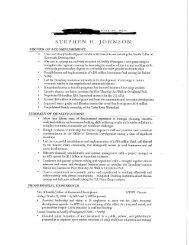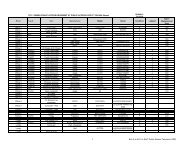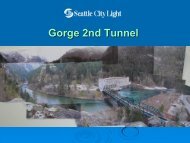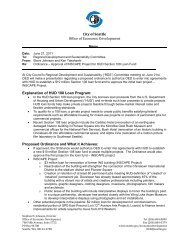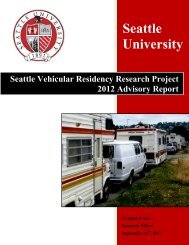2013 Water System Plan, Volume II - Seattle City Clerk's Office - City ...
2013 Water System Plan, Volume II - Seattle City Clerk's Office - City ...
2013 Water System Plan, Volume II - Seattle City Clerk's Office - City ...
You also want an ePaper? Increase the reach of your titles
YUMPU automatically turns print PDFs into web optimized ePapers that Google loves.
Chapter 5 <strong>Water</strong> Infrastructure<br />
A. Cast Iron Pipe<br />
Much of the SPU <strong>Water</strong> <strong>System</strong> piping is non-restrained, inflexible cast iron pipe with<br />
lead joints. No matter how robust a system design may be for crossing a given fault or<br />
landslide zone, if a connection to the existing pipe is faulty it will fail when the ground<br />
moves. Either of two methods will stabilize the structure within the zone:<br />
1. Extend flexible restrained joint pipe a significant distance beyond the fault/slide<br />
zone.<br />
2. Install some immovable structure on the new flexible restrained pipe near its<br />
connection with the existing pipe.<br />
B. Ductile Iron Pipe<br />
Where smaller (≤24”) diameter pipes cross movement prone areas, they are usually<br />
ductile iron. The options are:<br />
Standard Flexible Restrained joint pipe with expansion fitting(s) such as a<br />
restrained telescoping sleeve. A telescoping sleeve allows axial elongation of<br />
the piping system.<br />
Restrained Ball Joint pipe with expansion fitting(s) such as a restrained<br />
telescoping sleeve. Ball joint pipe is the most flexible and the most expensive<br />
pipe available. The balls must be encased in polyethylene bags to keep dirt out<br />
of the ball.<br />
Standard Flexible Restrained joint pipe with double ball expansion joints<br />
placed where the most differential movement is expected. Flexible<br />
Single/Double Ball Expansions Joints are discussed in DSG section 5.6.3.9.E.<br />
Currently these fittings are only available up to 48-inch diameter and one size<br />
beyond at 72 inches. The large-diameter sizes are extremely expensive.<br />
See Appendix C for the allowable ductile iron deflections. In all of the options above,<br />
shorter sections of pipe with extra joints can be used to provide more pipeline flexibility.<br />
C. Steel Pipe<br />
Where larger (≥24”) diameter pipes cross movement prone areas, they are generally<br />
steel. Steel pipe is somewhat flexible and the nature of the material allows it to yield<br />
and elongate significantly before failure. Some studies indicate that good welds can<br />
elongate 20% before failure. However, bending and buckling of the steel pipe can be a<br />
problem when the settlement trough is not smooth. Best options for steel pipes are:<br />
Full penetration butt welded steel for heavier wall thickness than normal. See<br />
DSG section 5.6.3.9B1. Steel pipe with no special fittings works well for long<br />
smooth settlement troughs. See Virtual Vault plan set 774-569 for an example<br />
of a 24-inch butt welded steel pipe with several design features included to<br />
increase seismic survivability of the system in a liquefiable zone.<br />
Full penetration butt welded steel with expansion fittings. Large-diameter<br />
steel expansion sleeves are available, but offer little expansion or deflection<br />
capability. If possible, double ball joint expansion fitting(s) should be installed if<br />
large differential ground movements are expected. Due to their current limited<br />
SPU Design Standards and Guidelines<br />
5-45



